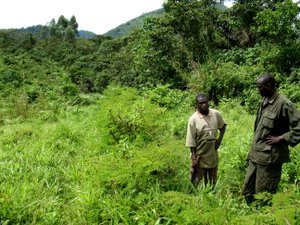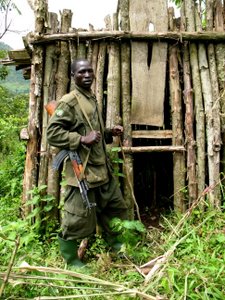|
Around Bwindi Impenetrable
National Park (BINP) the “front-line communities” often loose
substantial portions of their crops to wild animals. To mitigate
Human-Wildlife Conflicts (HWCs) several interventions have been tried
around BINP, these included
hedges of Mauritius thorn
(Caesalpinia decapetala (Roth) Alston), tea crop, keeping buffer areas open for liv estock grazing, and
selective killing of baboons. estock grazing, and
selective killing of baboons.
However, there is no
information on the effectiveness of such HWC mitigation interventions.
Secondly, Caesalpinia, an exotic plant with a history of invading
habitats elsewhere require careful investigation for promotion as a
hedge along the park boundary. The objectives of this study were to
investigate the invasive potential of Caesalpinia and the
effectiveness of Caesalpinia hedge and other interventions in
alleviating HWCs.
Mauritius thorn hedge (in middle of photo)
Community perceptions on the effectiveness of
Caesalpinia hedge and other HWC interventions, and institutional
mechanisms for managing HWC were also investigated. Data were collected
on reproductive ecology of Caesalpinia, factors limiting seed
germination, seedling survival, growth, population and impacts of
Caesalpinia on regeneration of indigenous vegetation. Growth and
survival features of Caesalpinia were compared with that of the
indigenous congeneric shrub species, Mezoneuron angolense
(Olive). The levels of effectiveness of Caesalpinia hedges and
other interventions were determined. Questionnaire was administrated to
assess community perceptions regarding Caesalpinia hedges and other HWC
interventions.
The result indicated that
Caesalpinia had both autogamous and cross-pollination breeding
systems. Cross-pollination was promoted by a variety of agents such as
sunbirds (Nectirinii), bees and Papilio species.
Caesalpinia also reproduced vegetatively by sprouting from exposed
roots. This meant that reproduction in Caesalpinia was not pollen
limited. Flower abortion and loss was high due to infection by fungus,
insect and bird predation. Caesalpinia fruit dispersal was not
favoured by humid and cool conditions in BINP. Fungal infestation of
seeds rapidly decreased viability. Rodent species predated on immature
Caesalpinia fruits, leading to 48 – 85% fruit loss. There was
highly significant correlation (R2 = 0.987, p < 0.005)
between amount of sunlight and seed germination. Hot water treatment
increased percentage germination while direct fire damaged seeds.
Caesalpinia started flowering within nine months of planting.
Compared to the indigenous congeneric species of Mezoneuron angolense
(Oliver), which grew well under various natural conditions, growth of
Caesalpinia was limited by poor soil nutrient status. Caesalpinia
seedling survival were also suppressed by combined effects of canopy
cover, ground vegetation cover and root competition (R2 =
0.852, p < 0.005). Exotic boundary plants of Cupressus and
Eucalyptus similarly suppressed growth of Caesalpinia,
probably through allelopathy, reduced nutrients, and light.
Caesalpinia did not negatively affect soil nutrient status and
regeneration of indigenous tree species. Population structure of
Caesalpinia indicated retrogressive trend, with over 80 % reduction
in area coverage over 9-year period.
 Baboons and bush pigs were
the main problem animals and contributed to over 90% to the crop
depredation in this study. The local perception was that HWC had
increased since the park was gazetted in 1991. Regarding mitigation
measures, Caesalpinia hedge and tea resulted in significant
reduction in baboon raids. Using a buffer zone for non-attractive
activities reduced raiding by bush pigs (over 60%) and could work for
Mountain gorillas. Baboons and bush pigs were
the main problem animals and contributed to over 90% to the crop
depredation in this study. The local perception was that HWC had
increased since the park was gazetted in 1991. Regarding mitigation
measures, Caesalpinia hedge and tea resulted in significant
reduction in baboon raids. Using a buffer zone for non-attractive
activities reduced raiding by bush pigs (over 60%) and could work for
Mountain gorillas.
Although Caesalpinia
is invasive elsewhere, factors ranging from suppression
by indigenous vegetation, fruit, seed predation and fungal infections
provided biological control to its expansion in BINP. The findings
suggest that Caesalpinia may not invade natural habitats in BINP
or other habitats with similar habitat characteristics.
Ranger at baboon trap in the bufferzone of
Nkuringo, on the south side of BINP |

